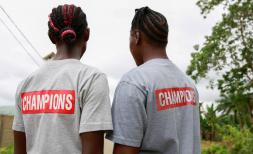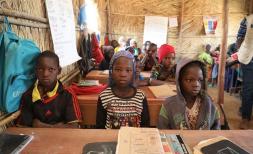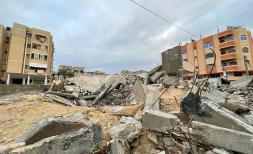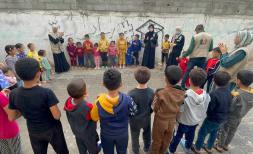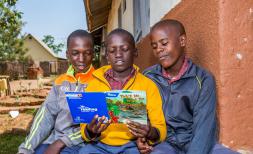Education under threat
Six months on from the pledges and promises made at the Global Refugee Forum, refugee children are facing greater barriers than ever before.
The coronavirus pandemic has led to school closures in 194 countries around the world and we have seen the families, caregivers and teachers of over a billion children now facing the same challenge: how to keep education alive when schools are closed.
Radio or TV lessons, print-at-home learning materials, WhatsApp study groups and e-learning platforms have suddenly become familiar to millions of children and their families.
Together, the global scramble to create home and distance learning represents an effort to address the biggest education crisis the world's children have ever faced.
For millions of the world's most vulnerable children, however, COVID-19 exacerbated an existing education crisis. More than half of school-aged refugee children were not in school even before the pandemic hit; at secondary school age, nearly two-thirds were missing out.
It's vital the world's response to COVID-19 and the global education emergency it has created both includes these children – and learns from their experiences.
Maya stands in an education space in Zaatari refugee camp in Jordan.
The minority of refugee children who were in school, like Maya, who fled the war in Syria with her family seven years ago, face losing their education all over again. She had been in school in Za'atari camp in Jordan. Now she relies on distance learning through TV lessons, and she sends her homework to her teachers via WhatsApp.
Access to earning technology is far from universal globally; for refugee children it is particularly challenging – which means there is a huge risk of further excluding refugees – as well as other poorer and marginalised children – from realising their right to education.
Twenty-three percent of Syrian refugees in Jordan have no internet access at home. For those who do, visual or hearing impairments, data costs and access to devices can be huge challenges, with 46 percent of Syrian refugees in Jordan recently surveyed said their children were not accessing the government's online learning platform.
That's why Save the Children is building on the considerable expertise we have providing no-or-low tech distance learning in our education response to COVID-19, such as Interactive Radio Instruction to reach hundreds of thousands of children, or providing at home learning packs to over 100,000 children in Uganda, or the developing mental health and psychosocial resources such as the My Hero is You book – which has already been translated into over 100 languages.
Teachers like Brenda [right] walk miles around Rwamwanja settlement, Uganda each day to visit deliver home learning packs to more than 100,000 children, with support from Education Cannot Wait.
However, the rapid expansion of radio, TV and at-home learning to reach millions of children globally must not only build on the body of knowledge from providing education in emergencies in the past. It must also take the opportunity to dramatically expand the number of refugee children, including those out of school before the pandemic, who can access quality education resources in a way that was not plausible before. And it must do so in a way that keeps the children safe.
The urgency for refugee and displaced children is acute. 99% of children surveyed across 17 different crises say that education is a top priority for them, and parents and leaders in communities deeply affected by conflict consider education a number one priority.
A new review of the data on learning loss shows why - children face losing approximately 20% to 35% loss for every month that are out of school. This means children who have lost access to education for just three months could lose more than an entire year's learning.
And of course, while schools are closed, the risk to children of child labour, marriage, teenage pregnancy and exploitation will continue to grow. The Ebola crisis saw a 65 percent increase in teenage pregnancy in some communities while schools were closed, and early estimates predict that 10 million more girls will be out of school than before the pandemic once all schools reopen.
As UNHCR confirms that once again the number of displaced people has tragically broken records – with 30 to 34 million children now displaced - we are at a critical juncture. The historic set of pledges in support of education for refugees were made the first Global Refugee Forum. It's more critical than ever that the world unites behind these pledges with action.
Governments and donors must ensure that refugees' learning needs are included in national COVID-19 education response plans to ensure the continuity of education during the pandemic, with a focus on the most marginalised. These responses must recognise that refugee and host communities may have limited access to technology, and connectivity can be prohibitively expensive.
Donors must step up and fill Education Cannot Wait's funding needs for the COVID-19 response and for the remaining of its strategic period up to end of 2021, which requires an additional $304.3 million to its global fund and $2 billion in-country to support ten Multi-Year Resilience Programmes (Bangladesh, Palestine, Afghanistan, CAR, Chad, Ethiopia, Somalia, South Sudan, Syria and Uganda).
And governments must start to plan now for safe return to school if we are to build back a better, more resilient education systems that help all children, particularly refugees – to realise their right to a quality education.
The world's children are facing an unprecedented education emergency. Refugee children like Maya will feel the impact of that emergency more than most. As the world responds, we must ensure that they are our priority.
Around the world, Save the Children is working to support children and their families through the coronavirus pandemic, rapidly adapting our existing work whilst supporting countries with limited capacity to respond. We have launched our #SaveOurEducation campaign to tackle the global education emergency.
Donate today to support Save the Children's coronavirus response.
